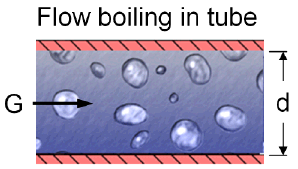
Flow Boiling

Procedure Flow_Boiling(Fluid$, T_sat, G, d, x, q``, OR$ : h, T_w ) implements the Shah (1982) correlation to determine the heat transfer coefficient for a boiling fluid in a tube considering both convective and nucleate boiling contributions as discussed in section 7.3.2 of Nellis and Klein.
Inputs
Fluid$ - string variable representing a real fluid in the EES data base.
T_sat - the saturation temperature of the incoming vapor in [C], [K], [F] or [R] (units depend on unit system selected in EES).
G - mass velocity, i.e., the ratio of the mass flow rate to the cross-sectional area of the tube [kg/s-m^2] or [lbm/hr-ft^2]
d - diameter of the tube [m] or [ft].
x - quality (must be between 0 and 1)
q`` - surface heat flux [W/m^2] or [Btu/hr-ft^2]
OR$ - a string constant or variable that must be either 'HORIZONTAL' or 'VERTICAL'
Outputs
h - heat transfer coefficient [W/m^2-K] or [Btu/hr-ft^2-F] including convective and nucleate boiling contributions.
T_w - estimated temperature of the inside surface of the tube in [C], [K], [F], or [R].
Notes:
1. This procedure is responsible for determining the property data of the specified fluid . Fluid$ must be a provided with a string variable or string constant that is one of the (non-ideal gas) fluids in EES. It uses the correlation developed by Shah (1982).
2. At x=1, the procedure returns that heat transfer coefficient expected for a single phase vapor at the given mass velocity and diameter
3. At high values of quality that would result in a Reynold's number less than 2300, linear interpolation is used between the heat transfer coefficient at a quality that results in Re=2300 and the x=1 value.
Example:
$UnitSystem SI K Pa J
F$='R22'
T_sat=250 [K] "boiling saturation temperature"
G=200 [kg/m^2-s] "mass velocity"
d=0.0172 [m] "tube inner diameter"
x=0.05 "quality"
call Flow_Boiling(F$,T_sat, G, d, x, q``, 'horizontal': h, T_w)
q``=U*(T_h-T_sat) "heat flux"
T_h=261 [K] "temperature of fluid on outside of pipe"
h_h=5400 [W/m^2-K] "heat transfer coefficient on outside surface of pipe"
U=(1/h+1/h_h)^(-1) "overall heat transfer coefficient between fluids on either side of the pipe wall"
{Solution: h=1,890 [W/m^2-K] and T_w=258.1 [K]}